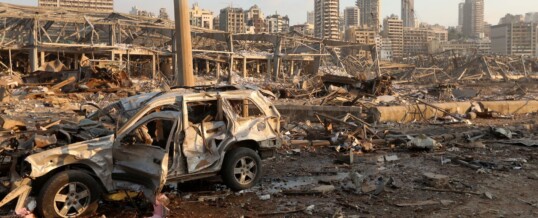
McLeod Group guest blog by Ruby Dagher, September 15, 2020
Given the ties between Canada and Lebanon, it was not surprising that that the Canadian government quickly announced a high-profile response to the humanitarian crisis prompted by the massive explosions in the heart of Beirut on August 4. Now, over a month later, the time is ripe for an initial stocktaking on this assistance, including its size, speed and partnerships. Sadly, there are serious concerns with all these aspects.
Lebanon’s Hiroshima
The explosions killed nearly 200 people, injured over 6,500, destroyed more than 50,000 houses and buildings, left over 300,000 people homeless, including 100,000 children, damaged nine hospitals and 178 schools, destroyed 15,000 tons of grain and caused an estimated US$15 billion in infrastructure damage, almost completely destroying the Port of Beirut, the country’s economic lifeline.
The explosions could not have happened at a worse time. The country was already reeling from a deep economic, political, and governance crisis. The poverty rate, standing at an estimated 55%, was the highest it had been in Lebanon’s modern history. The government had defaulted on its debt repayments and international financial institutions refused to lend Lebanon more money without serious economic and political reforms, a request that seemed impossible. The sanctions imposed by the United States and several European countries choked the economy.
Canada’s response
The Government of Canada took less than 48 hours to respond to the disaster in Lebanon. Initially, the government committed “up to”$5 million in humanitarian assistance. Of this amount, the Canadian government allocated $1.5 million to “trusted humanitarian organizations such as the Lebanese Red Cross” for emergency shelter, food, healthcare and medicine. Canada’s decision to distribute aid solely through non-governmental entities to avoid endemic corruption inside the Lebanese state was aligned with that of most non-Arab donors. Canada also launched a Lebanon Matching Fund for donations with an initial maximum matching value of $2 million. This soon increased to $5 million. On August 10, after participating in the International Conference on Assistance and Support to Beirut and the Lebanese People, Prime Minister Justin Trudeau announced an additional $25 million in humanitarian aid. The updated total of $30 million includes the Lebanon Matching Fund, which now has a maximum value of $8 million, and will be used to meet humanitarian needs and assist in early recovery.
According to the Canadian government, $13.5 million have already been earmarked to projects included in the US$565 million appeal launched by the United Nations on August 14. The Canadian commitments include $5 million to the World Food Programme, $2.5 million to UNICEF, $1.5 million to the UN refugee agency, $1 million to UN Population Fund and an additional $500,000 to the Lebanese Red Cross.
In this instance, Canada has done well not to work with the Lebanese state since such cooperation would help to legitimize a government and corrupt leaders who have lost popular support. Lebanon’s political leaders seem to cause crises, respond to them and then secure their power by becoming indispensable actors in the affected population’s lives.
Too little, too slow, and misplaced
The emergency International Conference cochaired by France and the UN raised €253 million, close to Cdn$395 million. While Canada’s $30 million is an important figure, it is a drop in the ocean, given the significant needs of the Lebanese people. Moreover, the Canadian government has not yet made public a timeline for the disbursement.
Second, and more critically, there is also no official Government of Canada document or announcement that indicates that any money has been transferred or disbursed. The Global Affairs Canada’s Project Browser automatically publishes projects with disbursements of $10,000 and above. As of the time of writing this, no new projects have been published for Lebanon since March.
Third, Canada has had an active diplomatic presence in Lebanon since 1958 and an active development and humanitarian assistance program since 1981. Canada boosted its presence and role following the 2006 war between Hezbollah and Israel. During this uptick in programming, significant work was accomplished in identifying local actors that were independent of political backers and terrorist organizations.
Yet, even with this knowledge, Canada has decided to work with large UN organizations and international NGOs that have significant administrative costs rather than with a network of local Lebanese civil society organizations that are trusted, have been active for years or decades, and employ locals. This foot-dragging reflects the government’s reluctance to delegate decision-making and financial management to the embassy level, with the exception of the Canada Fund for Local Initiatives. Canada is not living up to its 2016 commitment to spend 25% of its humanitarian assistance through local NGOs.
Recommendations
Overall, the way Canada has responded to the most recent disaster in Lebanon raises many concerns. I recommend that Canada:
1. Create a mechanism that can allocate uncommitted funds directly to local Lebanese organizations that are independent of political leaders, aspiring political leaders, political parties and militias, and the state. Given that most of the work for clean-up and reconstruction is being done by local unaffiliated volunteers and that Lebanon’s unemployment rate is extremely high, injections into local Lebanese civil society and NGOs can help increase the capacity of the sector, avoid large administrative costs, and increase employment.
2. Begin disbursing already announced funds as quickly as possible. Given that the Government of Canada has identified large international and multilateral organizations that have the capacity to start executing projects quickly, the money should start flowing now.
3. Establish a timeline for disbursement and commit to more funding in coming years. A staggered approach will help ensure that much-needed assistance continues to flow when donor fatigue begins to set in.
Ruby Dagher teaches at the School of International Development and Global Studies, University of Ottawa. Photo: Reuters/Mohamed Azakir.
